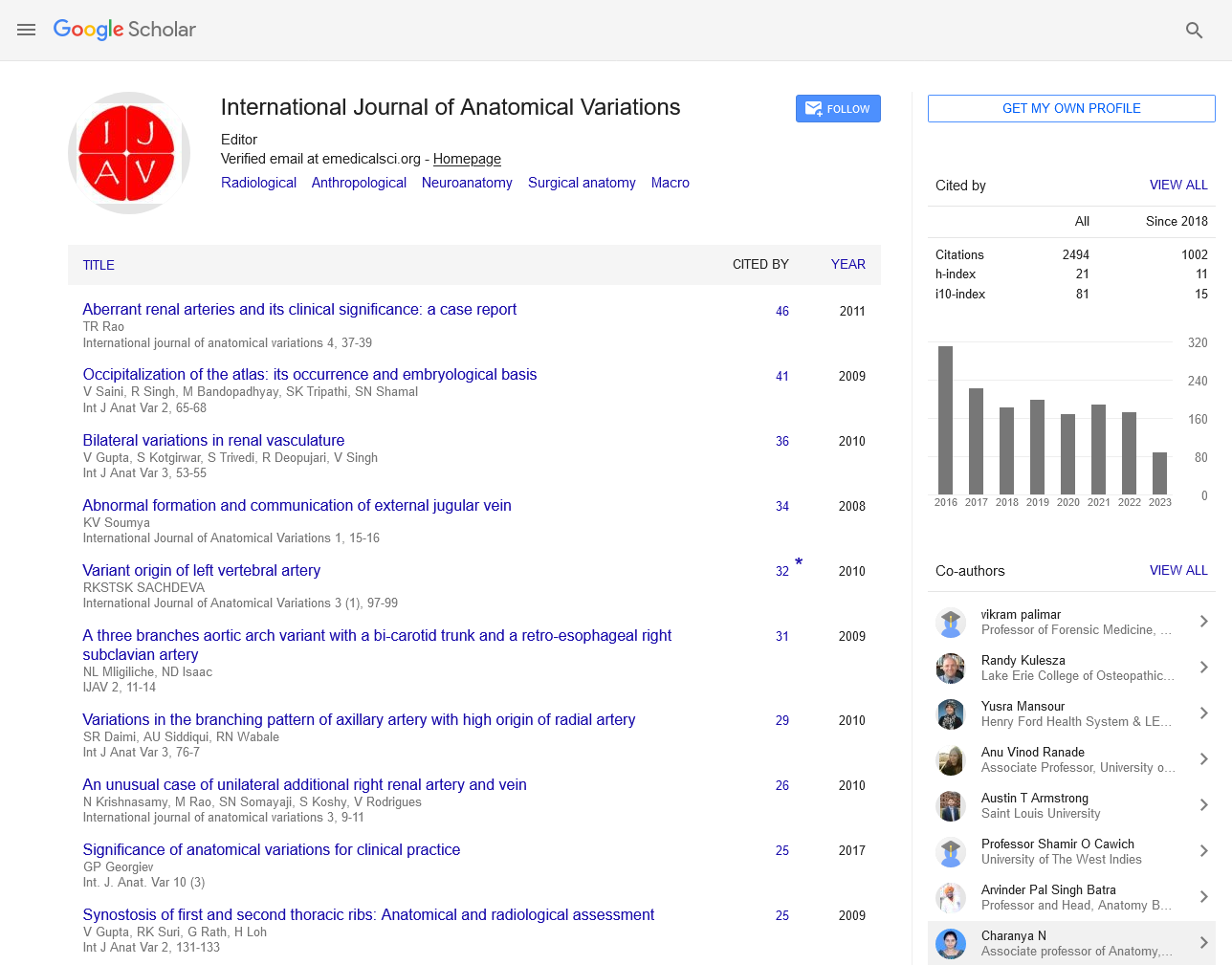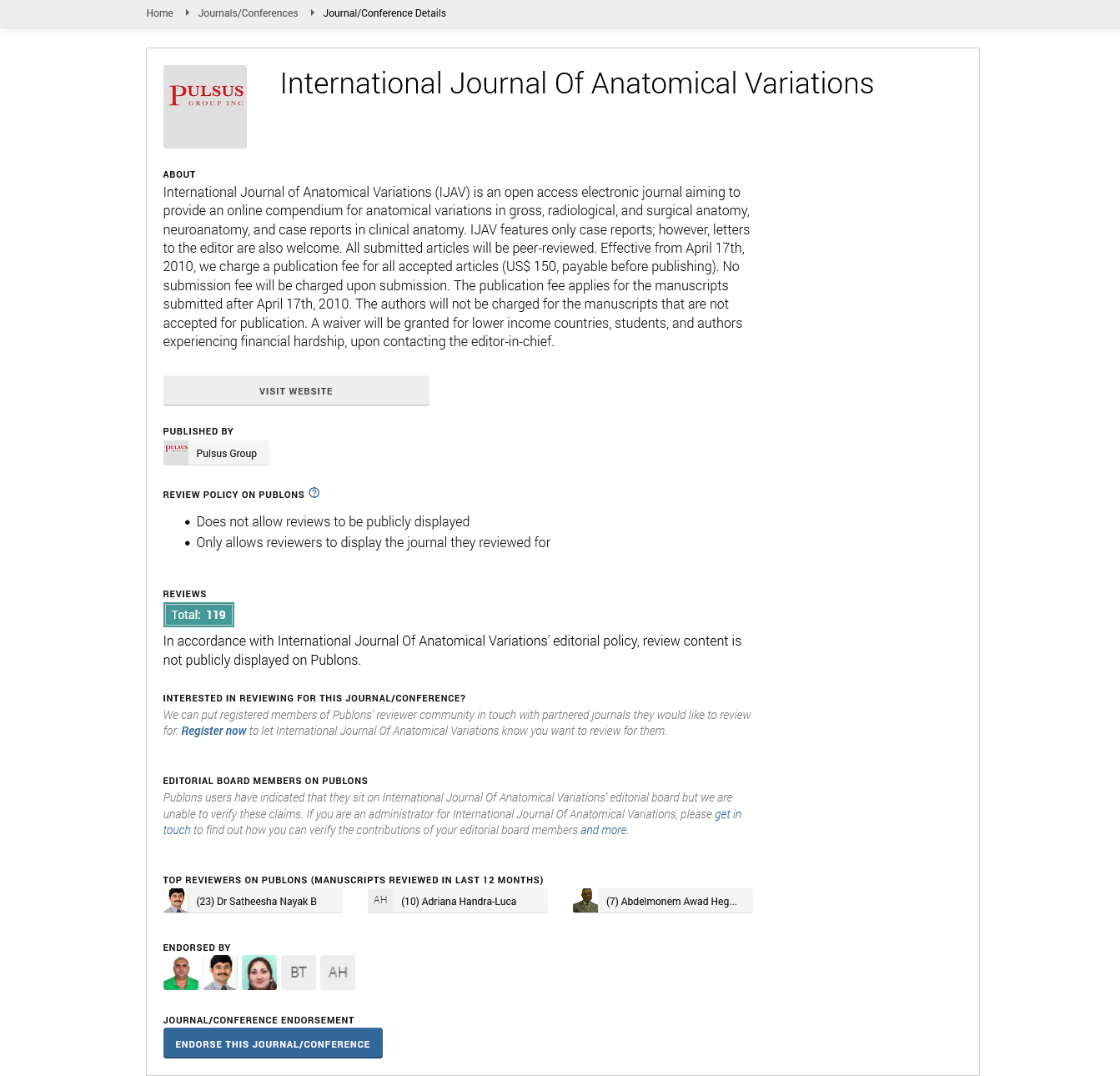Human Anatomy Structure Systems and Scientific Significance
Received: 01-Mar-2025, Manuscript No. ijav-25-7643; Editor assigned: 04-Mar-2025, Pre QC No. ijav-25-7643 (PQ); Reviewed: 19-Mar-2025 QC No. ijav-25-7643; Revised: 26-Mar-2025, Manuscript No. ijav-25-7643 (R); Published: 30-Mar-2025, DOI: 10.37532/1308 4038.18(3).501
Citation: Singh D. Human Anatomy Structure Systems and Scientific Significance. Int J Anat Var. 2025; 18(3): 771-772
This open-access article is distributed under the terms of the Creative Commons Attribution Non-Commercial License (CC BY-NC) (http://creativecommons.org/licenses/by-nc/4.0/), which permits reuse, distribution and reproduction of the article, provided that the original work is properly cited and the reuse is restricted to noncommercial purposes. For commercial reuse, contact reprints@pulsus.com
Abstract
Anatomy, the branch of biology concerned with the structure of organisms and their parts, serves as a cornerstone of medical and biological sciences. Human anatomy specifically focuses on the internal and external structures of the human body. This article offers a comprehensive exploration of human anatomy, covering historical development, classification, major body systems, microscopic anatomy, and the relevance of anatomy in medical and research contexts.
INTRODUCTION
Human anatomy, derived from the Greek word anatome, meaning “dissection,” has been a pivotal field since ancient civilizations. Understanding the human body’s structure is crucial for diagnosing diseases, performing surgeries, and advancing biomedical research. This paper explores the major components of human anatomy [1], including its systems, structural hierarchy, and the tools used to study it. Human anatomy, the scientific study of the body's structures, forms the bedrock of medical science and health-related disciplines. From the arrangement of cells to the intricate organization of complex organ systems, anatomy provides critical insights into how the human body functions, adapts, and responds to both internal and external environments. Understanding anatomical structure is essential not only for clinical practice but also for advancing research in fields such as biomedical engineering, genetics, and physiology [2]. Throughout history, the exploration of human anatomy has shaped the evolution of medicine. Early anatomical knowledge was often limited by cultural and religious constraints, yet groundbreaking work by pioneers like Hippocrates, Galen, and Vesalius laid the foundation for modern anatomical science. Today, anatomy is studied using a variety of sophisticated tools, from cadaveric dissection to advanced imaging technologies like MRI and CT scans, allowing for greater precision and deeper comprehension of bodily structures. This article explores the detailed architecture of the human body, examining its hierarchical organization from cells to systems. It also highlights the major anatomical systems that sustain life and discusses the broader scientific significance of anatomy in medical education, diagnostics, and innovation. By delving into the structural and functional aspects of the human body, we uncover not only the complexity of life but also the remarkable coherence that underlies human biology [3].
HISTORICAL BACKGROUND
Human anatomy dates back to ancient Egypt and Greece. Pioneers like Hippocrates and Galen laid early foundations [4], but the Renaissance marked a turning point, with Andreas Vesalius’ De Humani Corporis Fabrica revolutionizing anatomical knowledge. Modern anatomy integrates imaging technologies and computer modeling, greatly expanding the precision and scope of anatomical science.
MAJOR SYSTEMS OF THE HUMAN BODY
Comprising 206 bones, the skeletal system provides support, protection, and facilitates movement. It also serves as a reservoir for minerals and produces blood cells in the bone marrow. Includes skeletal, smooth, and cardiac muscles, responsible for movement, posture, and heat generation. The brain, spinal cord, and peripheral nerves form the control center, coordinating bodily functions and responses. Consists of the heart, blood, and blood vessels, transporting oxygen, nutrients, hormones, and waste. Facilitates gas exchange through lungs, nasal passages, and trachea. Processes food, absorbs nutrients, and expels waste through a complex series of organs including the stomach, intestines, and liver. Removes waste and maintains water and electrolyte balance via kidneys, ureters, bladder, and urethra. Regulates body functions through hormones released by glands such as the pituitary, thyroid, and pancreas. Defends against pathogens and maintains fluid balance with organs like lymph nodes and the spleen [5].
CHALLENGES AND FUTURE DIRECTIONS
Emerging fields like virtual anatomy and AI-enhanced imaging are reshaping how anatomy is taught and applied. Ethical challenges persist in cadaver acquisition and data privacy in imaging. Future anatomy may integrate personalized medicine and genomics to an unprecedented degree.
CONCLUSION
Human anatomy remains an essential, evolving science foundational to medicine and biology. Through centuries of study and technological innovation, our understanding of the human body continues to deepen, enabling advances in health care and human biology.
REFERENCES
- Cui RR, Wright JD, Hou JY. Uterine leiomyosarcoma: a review of recent advances in molecular biology, clinical management and outcome.BJOG: Int. J Obstet Gynaecol. 2017; 124(7):1028–1037.
- Santos P, Cunha TM. Uterine sarcomas: Clinical presentation and MRI features.Diagnostic and Interventional Radiology. 2015; 21(1):4–9.
- Cree IA, Tan PH, Travis WD, Wesseling Pet al.Counting mitoses: SI (ze) matters!Modern Pathology. 2021; 34:1651–1657.
- Huang YT, Huang YL, Ng KK, Lin G. Current status of magnetic resonance imaging in patients with malignant uterine neoplasms: A review.KJR. 2019; 20(1):18–33.
- Hughes L, Roex A, Parange A. STUMP, a surprise finding in a large fibroid uterus in a 20-year-old woman.Int J Womens Health. 2018; 10:211–214.
Indexed at, Google Scholar, Crossref
Indexed at, Google Scholar, Crossref
Indexed at, Google Scholar, Crossref
Indexed at, Google Scholar, Crossref






